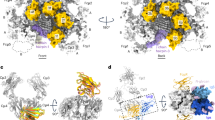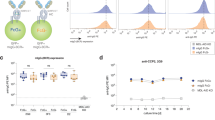Abstract
When antibody to immunoglobulin (anti-Ig) reacts with Ig molecules on B-lymphocyte surfaces the Ig, tethered by the antibody, moves over the surface to form patches and finally a cap at one pole of the cell. Simultaneously, the Ig–antibody complexes are removed by pinocytosis at the patches and cap, until the surface is cleared of the target molecules1,2. In immunofluorescent studies, Sidman and Unanue3 followed the reappearance of the surface Ig during subsequent culture of the cells. They observed that splenic lymphocytes from adult mice re-express surface Ig promptly, whereas those from neonatal animals re-express poorly or not at all. They suggested that this phenomenon might be related to the greater susceptibility of lymphocytes from immature animals to tolerisation by antigen. Such an interpretation was supported by a simultaneous study4 showing that explanted mouse fetal lymphocytes were less able to re-express surface Ig after treatment by anti-Ig than were adult lymphocytes. However, Ault and Unanue5 later reported in man a similar dichotomy between blood and nodal lymphocytes, the former re-expressing surface Ig more poorly. We report here studies on guinea pig leukaemic lymphocytes, which have also shown delayed re-expression of surface Ig after clearing by antibody. We present evidence that the delayed re-expression reflects a reduction in the normal delivery rate associated with turnover at the surface. The reduction follows a train of events initiated by cross-linking of the surface Ig and including an increase in intracellular cyclic AMP. Furthermore, the shutdown in delivery is apparently specific, inasmuch as delivery of two other surface molecules we have been able to quantify proceeds unimpeded. These observations suggest a basic mechanism expressed to varying extents by normal lymphoid populations to account for their differing rates of surface Ig regeneration3–5.
This is a preview of subscription content, access via your institution
Access options
Subscribe to this journal
Receive 51 print issues and online access
$199.00 per year
only $3.90 per issue
Buy this article
- Purchase on Springer Link
- Instant access to full article PDF
Prices may be subject to local taxes which are calculated during checkout
Similar content being viewed by others
References
Taylor, R. B., Duffus, W.P.H., Raff, M. C. & de Petris, S. Nature new Biol. 233, 225–229 (1971).
Schreiner, G. F. & Unanue, E. R. Adv. Immun. 24, 37–165 (1976).
Sidman, C. L. & Unanue, E. R. Nature 257, 149–151 (1975).
Raff, M. C. et al. J. exp. Med. 142, 1052–1064 (1975).
Ault, K. A. & Unanue, E. R. J. Immun. 119, 327–329 (1977).
Nadel, E., Liu, P. & Burstein, S. Beitr. Path. Bd. 151, 268–280 (1974).
Stevenson, G. T., Eady, R. P., Hough, D. W., Jurd, R. D. & Stevenson, F. K. Immunology 28, 807–820 (1975).
Shevach, E. M., Ellman, L., Davie, J. M. & Green, I. Blood 39, 1–12 (1972).
Hough, D. W., Chapple, J. C., Stevenson, F. K. & Stevenson, G. T. Immunology 34, 889–899 (1978).
Axén, R., Porath, J. & Ernback, S. Nature 214, 1302–1306 (1967).
Schwartz, B. D., Kask, A. M., Paul, W. E. & Shevach, E. M. J. exp. Med. 143, 541–558 (1976).
Hough, D. W., McIlroy, B. M. & Stevenson, G. T. Immunology 32, 337–343 (1977).
Graham, J. M., Sumner, M. C. B., Curtis, D. H. & Pasternak, C. A. Nature 246, 291–295 (1973).
Virji, M. & Stevenson, G. T. Br. J. Cancer 39, 434–440 (1979).
Holmgren, J., Lönnroth, I., Månsson, J. E. & Svennerholm, L. Proc. natn. Acad. Sci. U.S.A. 72, 2520–2524 (1975).
Wedner, H. J. & Parker, C. W. Prog. Allergy 20, 195–300 (1976).
Vitetta, E. S. & Uhr, J. W. Immun. Rev. 37, 50–88 (1978).
Stevenson, G. T., Elliott, E. V. & Stevenson, F. K. Fedn Proc. 36, 2268–2271 (1977).
Author information
Authors and Affiliations
Rights and permissions
About this article
Cite this article
Glennie, M., Stevenson, F., Stevenson, G. et al. Cross-linking of lymphocytic surface immunoglobulin inhibits its production via a cyclic nucleotide mechanism. Nature 281, 305–307 (1979). https://doi.org/10.1038/281305a0
Received:
Accepted:
Issue Date:
DOI: https://doi.org/10.1038/281305a0
This article is cited by
-
Treatment of lymphoid tumors with anti-idiotype antibodies
Springer Seminars in Immunopathology (1983)
Comments
By submitting a comment you agree to abide by our Terms and Community Guidelines. If you find something abusive or that does not comply with our terms or guidelines please flag it as inappropriate.



